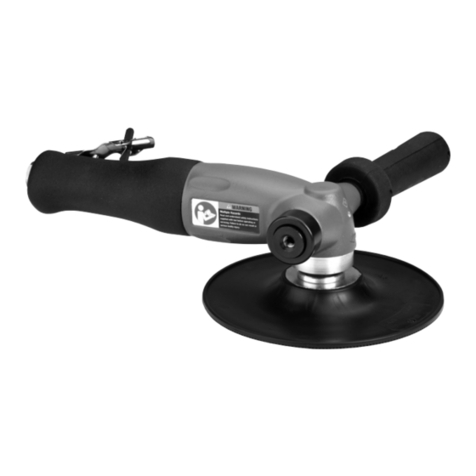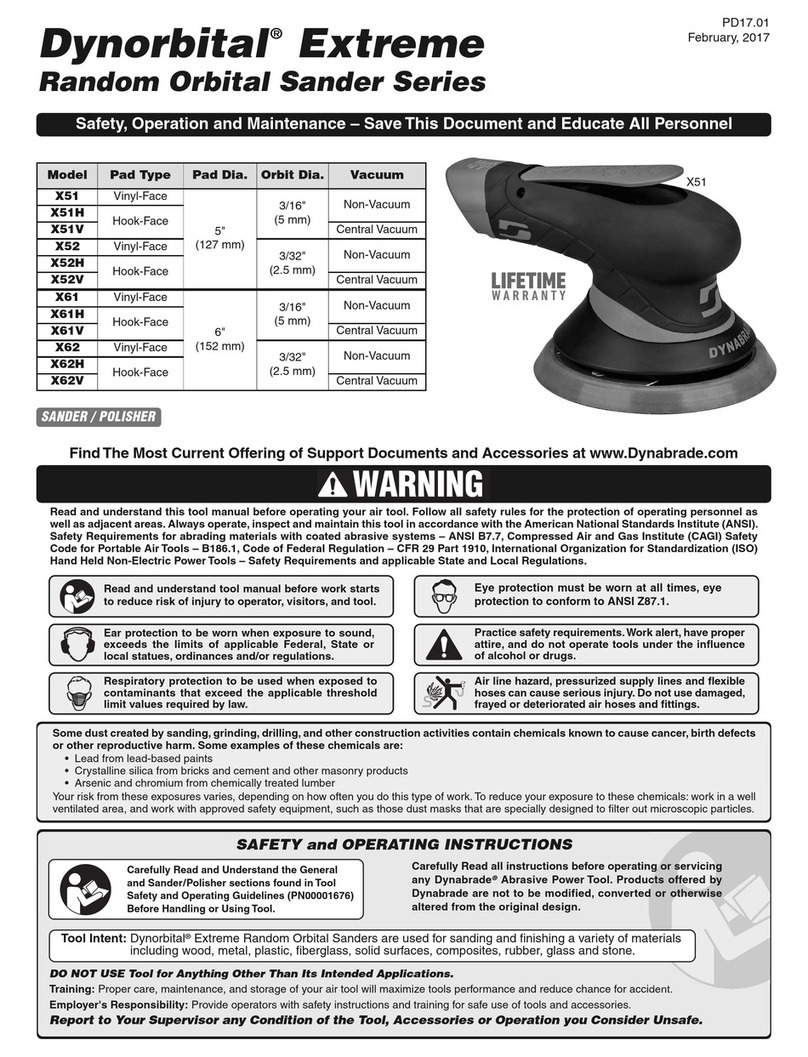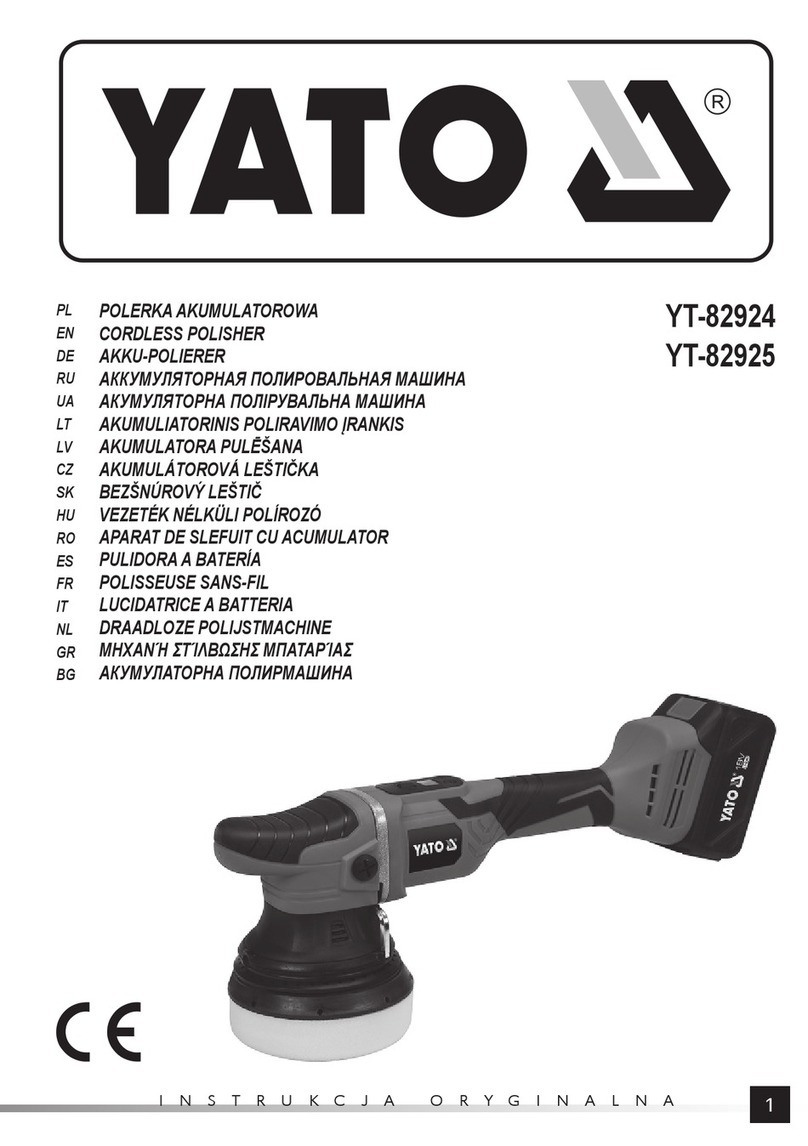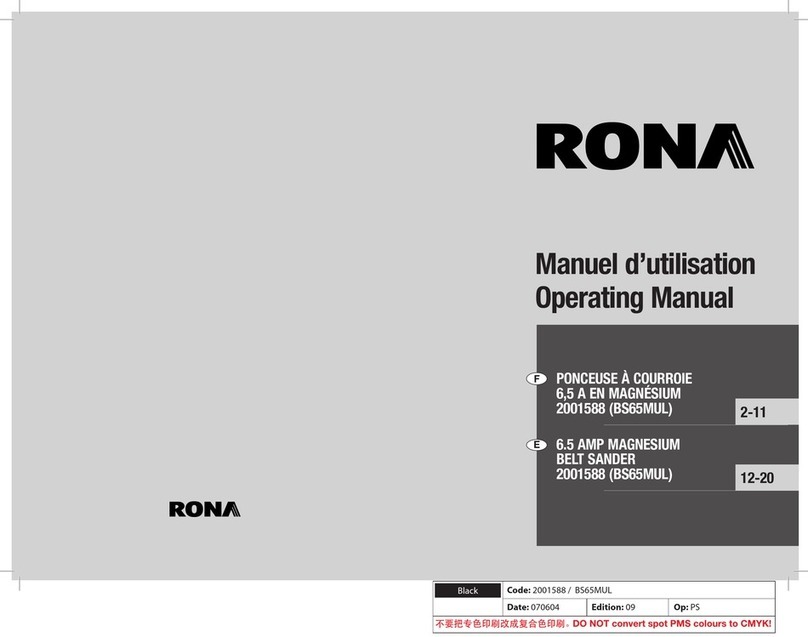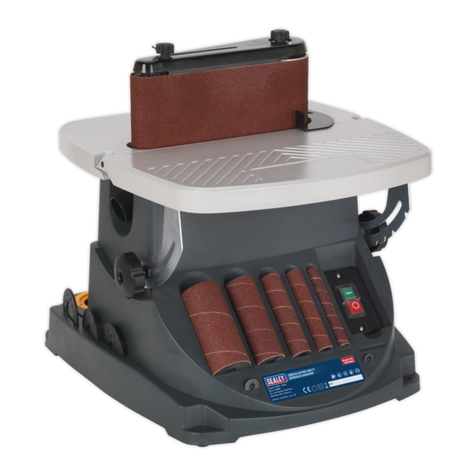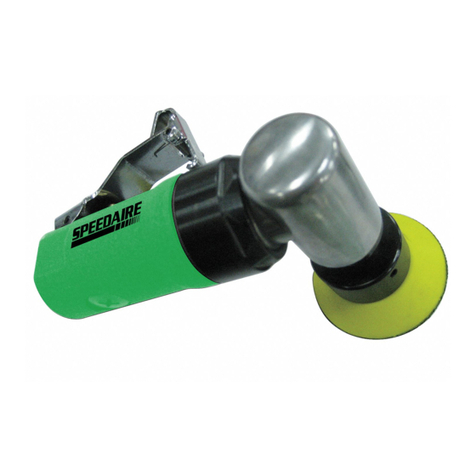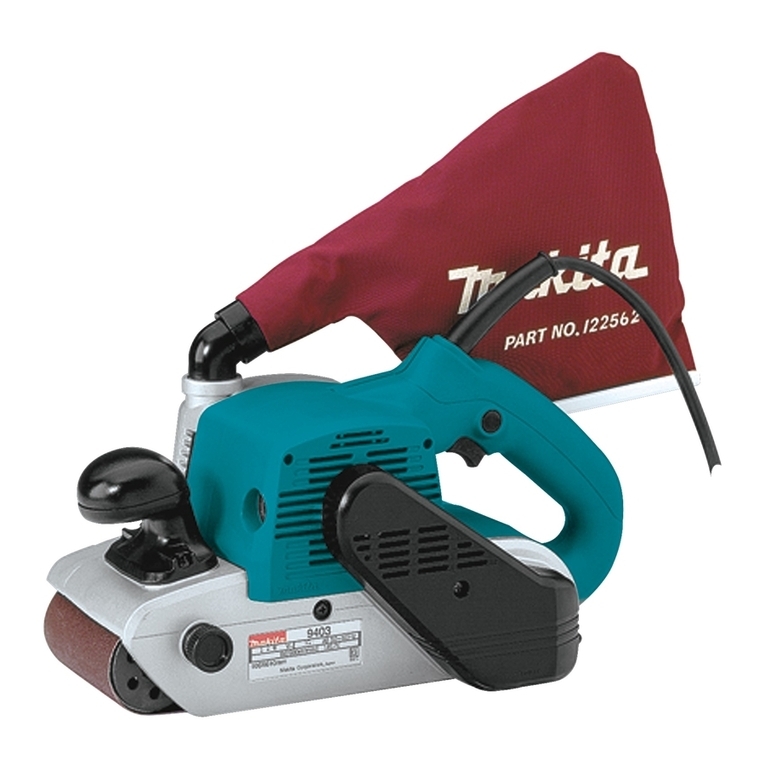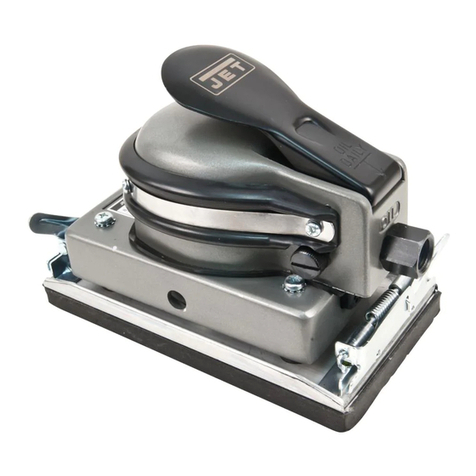Clarke American Sanders 07057A User manual

Form No. 78425C 3/08 revised 1/11
This book has important information for the use and safe operation of this machine. Failure to read
this book prior to operating or attempting any service or maintenance procedure to your Clarke
American Sanders machine could result in injury to you or to other personnel; damage to the
machine or to other property could occur as well. You must have training in the operation of this
machine before using it. If your operator(s) cannot read this manual, have it explained fully before
attempting to operate this machine.
All directions given in this book are as seen from the operator’s position at the rear of the ma-
chine.
EZ-8
Sander
READ THIS BOOK
LEA ESTE MANUAL
LISEZ CE MANUEL
Operator's Manual/Manual del operador/Manuel de l’utilisateur
Models: 07057A, 07058A, 07059A, 07060A
English (2 - 13)
Español (14 - 25)
Français (26 - 37)
ES
EN
FR

EN
ENGLISH
-2- Form No. 78425C Clarke®American Sanders Operator's Manual (EN) - EZ-8 Sander
Contents of this Book
Operator Safety Instructions........................................................ 3
Introduction and Machine Specifications..................................... 5
How to Transport the Machine..................................................... 6
Machine Set-Up........................................................................... 7
How to Operate the Machine....................................................... 9
Sanding Cuts and Sandpaper .................................................. 10
Sander Adjustment Procedures..................................................11
Routine Maintenance................................................................. 12
Troubleshooting......................................................................... 13
Section II Parts and Service Manual
Assembly Drawing #1 ............................................................... 40
Assembly Parts List #1 ............................................................. 41
Assembly Drawing #2................................................................ 42
Assembly Parts List #2.............................................................. 43
Wiring Diagram.......................................................................... 44
WARNING: The Products sold with this Manual contain or may contain chemicals that are known to certain governments (such
as the State of California, as identified in its Proposition 65 Regulatory Warning Law) to cause cancer, birth defects or other repro-
ductive harm. In certain locations (including the State of California) purchasers of these Products that place them in service at an
employment job site or a publicly accessable space are required by regulation to make certain notices, warnings or disclosures
regarding the chemicals that are or may be contained in the Products at or about such work sites. It is the purchaser’s responsibility
to know the content of, and to comply with, any laws and regulations relating to the use of these Products in such environments. The
Manufacturer disclaims any responsibility to advise purchasers of any specific requirements that may be applicable to the use of the
Products in such environments.

EN
ENGLISH
Clarke®American Sanders Operator's Manual (EN) - EZ-8 Sander Form No. 78425C - 3 -
OPERATOR SAFETY INSTRUCTIONS
DANGER means: Severe bodily injury or death can occur to you or other personnel if the
DANGER statements found on this machine or in this Operator’s Manual are
ignored or are not adhered to. Read and observe all DANGER statements
found in this Operator’s Manual and on your machine.
WARNING means: Injury can occur to you or to other personnel if the WARNING statements
found on your machine or in this Operator’s Manual are ignored or are not
adhered to. Read and observe all WARNING statements found in this
Operator’s Manual and on your machine.
CAUTION means: Damage can occur to the machine or to other property if the CAUTION state-
ments found on your machine or in this Operator’s Manual are ignored or are
not adhered to. Read and observe all CAUTION statements found in this
Operator’s Manual and on your machine.
DANGER: Failure to read the Operator’s Manual before operating or servicing this sanding equipment
could result in injury to the operator or to bystanders and could cause damage to the equip-
ment. Read and observe all safety statements found in this manual and on the sanding equip-
ment. Make sure all labels, decals, warnings, cautions and instructions are fastened to the
equipment. Replace any that are damaged or missing. You must have training in the opera-
tion of this equipment before using it. If the operator is unable to read this manual, have it
explained fully before they attempt to use this equipment.
DANGER: Sanding/finishing wood floors can create an environment that can be explosive. The following
safety procedures must be adhered to:
• Cigarette lighters, pilot lights and any other source of ignition can create an explosion when
active during a sanding session. All sources of ignition should be extinguished or removed
entirely if possible from the work area.
• Work areas that are poorly ventilated can create an explosive environment when certain
combustible materials are in the atmosphere, i.e., solvents, thinners, alcohol, fuels, certain
finishes, wood dust and other combustible materials. Floor sanding equipment can cause
flammable material and vapors to burn. Read the manufacturer’s label on all chemicals
used to determine combustibility. Keep the work area well ventilated.
• Spontaneous combustion or an explosion can occur when working with sanding dust. The
sanding dust can self-ignite and cause injury or damage. Sanding dust should be disposed
of properly. Always empty the sanding dust into a metal container that is located outside of
any building(s).
• Remove the contents of the dust bag when the bag is 1/3 full. Remove the contents of the
dust bag each time you finish using the equipment. Never leave a dust bag unattended with
sanding dust in it.
• Do not empty the contents of the dust bag into a fire.
• Hitting a nail while sanding can cause sparks and create an explosion or fire. Always use a
hammer and punch to countersink all nails before sanding floors.

EN
ENGLISH
-4- Form No. 78425C Clarke®American Sanders Operator's Manual (EN) - EZ-8 Sander
DANGER: Operating partially assembled sanding equipment could result in injury to the operator or bystander and
could cause damage to the equipment or to other property.
• Do not operate this equipment unless it it fully assembled and all guards, doors and covers are se-
cured.
• Keep all fasteners tight.
• Keep all adjustments within manufacturers specifications.
DANGER: Moving parts on this sanding equipment can cause injury to the operator or bystanders.
• Keep hands, feet and loose clothing away from all moving parts.
• Do not change or adjust the abrasive while the sanding equipment is running.
• Do not service the sanding equipment while it is running.
DANGER: This sanding equipment requires a supply of electricity. Improper use could result in electrical shock or
fire.
• Connect only to an electrical source matching what is shown on the equipment nameplate.
• Do not use this sanding equipment on an ungrounded electrical circuit. Consult an electrician if you
suspect the circuit is not properly grounded.
• Do not use this sanding equipment with a damaged electrical cord. Inspect before each use.
• Avoid striking the elelctrical cord with the abrasive. Always lift the electrical cord over the sanding
equipment.
• Do not use the electrical cord to move the sanding equipment.
• Disconnect the electrical source before servicing this equipment.
WARNING: In the event of a bag fire, injury can occur to the operator if the operator is tied or strapped to equipment.
Use operating belt properly.
WARNING: Injury to the operator or bystander can occur if protective gear is not worn while sanding. Always use eye,
ear, and respiratory protection while performing any sanding operation.
WARNING: This sander is not to be used on pressure treated wood. Some pressure treated woods contain arsenic and
sanding pressure treated wood produces hazardous dust. Inhaling hazardous dust from pressure treated
wood can cause serious injury or death. Sanding pressure treated wood decks or uneven surfaces can
damage the sander which is not covered under warranty or damage waiver.
WARNING: Bodily injury could occur if power is applied to the equipment with the power switch already in the “ON”
position. Always check to assure that the power switch is in the “OFF” position before connecting power
supply.
CAUTION: Maintenance and repairs performed by unauthorized personnel could result in damage or injury. Mainte-
nance and repairs performed by unauthorized personnel will void your warranty. Servicing of this unit must
always be referred to an authorized Clarke American Sanders distributor.
CAUTION: Use of this equipment to move other objects or to climb on could result in injury or damage. Do not use this
equipment as a step or furniture. Do not ride on this equipment.
CAUTION: Damage could occur to the equipment if not properly kept in a dry building for storage. Store the equip-
ment in a dry building.
CAUTION: The equipment is heavy. When transporting the equipment, remove the motor. Get help to lift the equip-
ment and motor.
CAUTION: Serious damage to the floor can occur if the sanding equipment is left running in one spot while the sanding
drum is in contact with the floor. To avoid damage to the floor, feather cut in at a normal sanding rate. Do
not dwell while lowering or raising the contact wheel. Always sand at a constant rate.

EN
ENGLISH
Clarke®American Sanders Operator's Manual (EN) - EZ-8 Sander Form No. 78425C - 5 -
Model 07057A 07058A 07059A 07060A
Abrasive Size 8 in x 193/16 in 8 in x 19 in 8 in x 193/16 in 8 in x 19 in
sheet sleeve sheet sleeve
Abrasive Rate 2680 ft/min 2830 ft/min 2230 ft/min 2360 ft/min
Drum Rate 1800 RPM 1800 RPM 1500 RPM 1500 RPM
Dust Control Rate 76 CFM 76 CFM 64 CFM 64 CFM
Drum Pressure 25 lbs 25 lbs 25 lbs 25 lbs
Leveling Controls
Externally Externally Externally Externally
Adjustable Adjustable Adjustable Adjustable
Operating Controls
Lever Lever Lever Lever
Operated Operated Operated Operated
Motor 1½ HPTEFC 1½ HPTEFC 1½ HPTEFC 1½ HPTEFC
Thermally Thermally Thermally Thermally
Protected Protected Protected Protected
Power Cable 40’ 12 Gauge 40’ 12 Gauge 40’ 12 Gauge 40’ 12 Gauge
Abrasive Abrasive Abrasive Abrasive
Resistant Resistant Resistant Resistant
Voltage/Frequency
115 / 60 115 / 60 240 / 50 240 / 50
Amperage 12 12 6 6
Dimensions (in)* 21½x16x35½” 21½x16x35½” 21½x16x35½” 21½x16x35½”
Weight (lbs)* 125 125 125 125
*Shipping Value
CAUTION: Your equipment may be inappropriate on some installations. Always consult with
the flooring manufacturer on the proper installation, preparation, and finishing of
their product. Determine suitability of your equipment in preparing the product.
Operating
Control Lever
Control Switch
Control Link
Transport Handle
Dust Pipe
Locking Collar
Handle Latch
Level Adjustment
Drum Cover
Introduction & Machine Specifications

EN
ENGLISH
-6- Form No. 78425C Clarke®American Sanders Operator's Manual (EN) - EZ-8 Sander
How to Transport the Machine
Transporting the Machine With Limited
Cargo Area:
To transport the machine, follow this procedure:
1. Lower sanding drum with control lever. See
figure #1.
2. Slide collar beyond overlap of control link;
remove pin from notch. See figure #2.
3. Twist and remove handle pigtail from motor
cord. See figure #3.
4. Release handle latches and remove handle
from chassis. See figure # 2.
5. Remove dust pipe from chassis.
6. Lift chassis with transport handles and place in
cargo area. See figure # 4.
WARNING:Machine is heavy (95 lbs.).
To avoid injury or damage
grasp transport handles firmly;
use proper lifting technique.
7. Secure chassis to prevent movement in cargo
area. Place handle and dust pipe in cargo area.
Figure # 4
Figure # 1
Figure # 2
Figure # 3

EN
ENGLISH
Clarke®American Sanders Operator's Manual (EN) - EZ-8 Sander Form No. 78425C - 7 -
Machine Set-up
To set up the machine follow this procedure:
1. Familiarize yourself with the machine. Read all
danger, warning, and caution statements as well
as the Operator’s Manual. If operator is unable
to read English, have the manual explained
before operating.
2. Install handle and fasten latches. See figure # 6.
3. Insert control link into notch and slide collar to
pin. Raise sanding drum with control lever. See
figure # 5 & # 6.
4. Install dust tube.
5. Connect the handle pigtail to the motor cord.
Align ground pin, insert and twist. See figure # 7.
6. To install abrasive on sanding drum equipped
with paper clamp: loosen screws to paper clamp
with a coin. Do not remove screws or clamp
from the sanding drum. Insert one edge of
abrasive under paper clamp. Rotate sanding
drum to wrap abrasive around drum. Insert other
edge of abrasive under paper clamp. Center
abrasive and take up any slack in the abrasive.
Tighten screws on paper clamp. Close drum
cover. See figure # 8.
To install abrasive on sanding drum equipped for
sleeve abrasive: slide abrasive over drum, center
abrasive, and close drum cover.
Figure # 5
Figure # 6
Figure # 7
Figure # 8

EN
ENGLISH
-8- Form No. 78425C Clarke®American Sanders Operator's Manual (EN) - EZ-8 Sander
Install the dust bag by
pressing the end onto the
exhaust tube until the ring
locks into the groove.
1.5" Hose from
vacuum system
(not included)
B
C
Exhaust Tube (30563A)
2" Tube x 1.5" hose adaptor
A
2" Hose from
vacuum system
(not included)
D
MACHINE SET-UP
7. This sanding machine is designed to be operated
with a remote vacuum dust collection system or
with the included dust bag. Follow the procedures
below:
Preparing Remote Vacuum Dust Collection Systems
To prepare the machine for remote vacuum dust collection
systems that have a 2” hose end, follow this procedure:
1. Install 2” hose end (figure 9, A) directly over the ex-
haust tube (figure 9, B).
2. The exhaust tube can be rotated for optimum conve-
nience.
To prepare the machine for remote vacuum dust collection
systems that have a 1 ½” hose end, follow this procedure:
1. Install the 2” x 1½” hose end adaptor (Part No.
30563A) (figure 9, C) over the exhaust tube (figure 9,
B).
2. Insert 1 ½” hose end (figure 9, D) into the adaptor
(figure 9, C).
NOTE: Start the remote vacuum collection system
before operation.
Preparing to use the included dust bag
To prepare the machine for use with the included dust bag,
follow this procedure:
1. Install the dust bag by pressing the end onto the
exhaust tube until the ring locks into the groove (figure
10). This is best done by pressing on the back of the
bag opening with the palm of your hand.
2. The exhaust tube can be rotated for optimum conve-
nience.
3. To remove the dust bag from the exhaust tube, pry
up the end of the bag opening to partially release the
internal rib from the groove, then pull.
4. To empty the dust bag, unzip the disposal flap and
force contents out by inverting the bag.
NOTE: For best results, empty frequently. Follow all
warnings posted in this manual and on the dust bag.
Figure 9
Figure 10

EN
ENGLISH
Clarke®American Sanders Operator's Manual (EN) - EZ-8 Sander Form No. 78425C - 9 -
1
3
2
4
How to Operate the Machine
To operate the machine follow this procedure:
Set any exposed nails with a hammer and punch1.
to avoid encounter with sanding drum. Connect
the machine to an appropriate grounded and
fused circuit (power supply). Press the selector
switch to the start (S) position. Once started,
allow switch to return to run (R) position.
CAUTION:To prevent damage to the surface,
make sure the machine is always
moving when the sanding drum is
in contact with the floor.
2. Work right to left. For each forward pass, move
the machine 4” over the pass you have just
finished. Retrace your reverse path without
overlapping. See figure # 11
3. Feather-cut in by easing the sanding drum down
onto the surface with the control lever while the
sander is in motion.
4. When sanding drum is fully engaged with the
surface, release control lever and adjust your
pace for adequate stock removal. Keep sander
in motion while the sanding drum is engaged with
the surface or dwell marks will occur.
5. Move the machine in the direction of the grain in
the wood whenever possible. Sand the surface
at a constant pace.
6. Gradually feather-cut out at the termination point
(the end of your pass) by easing the sanding
drum up with the control lever. Stagger the
termination points for a better blend when
edging. See figure # 11.
7. When replacing abrasive, emptying contents of
dust bag, or when sanding operation is com -
pleted, press selector switch to off (O) position.
Disconnect the machine from the power supply.
8. Empty dust bag whenever it is 1/3 full. Never
leave a dust bag unattended with sanding dust
in it. Sanding dust can spontaneously ignite and
cause a fire or explosion. Empty dust into a
metal container clear of any combustible
material.
Figure 11

EN
ENGLISH
-10- Form No. 78425C Clarke®American Sanders Operator's Manual (EN) - EZ-8 Sander
Sanding Cuts and Sandpaper
Initial Cut
The purpose of the initial cut is to remove old finish and gross imperfections on the floor surface. A coarse
abrasive should be used. If the surface is severely damaged by deep scratches, pre-existing dwell marks,
uneven planks, etc., it may be necessary to sand across or diagonally to the grain to restore evenness to the
surface. If these conditions are not present, the initial cut should be done in the direction of the grain.
If glazing, loading, or burning takes place immediately into an initial cut, select a coarser abrasive. If this
should occur during an initial cut, the abrasive has dulled and must be replaced.
Final Cuts
The purpose of a finishing cut is to remove the scratches produced during the initial cut. Use a fine (60 - 80
grit) grain abrasive.
If the surface remains rough after a finishing cut, it may be necessary to use an even finer grain of abrasive
(80 - 100 grit). Care should be taken in selecting the grit size of the abrasive. A very fine grain will close
the pores on a wood floor making admission of a stain difficult.
If glazing or burning should occur immediately into a finishing cut, increase pace. If it should occur during a
finishing cut, the abrasive has dulled and must be replaced.
Grain Use
12 grit For removing gross imperfections and restore
16 grit evenness to old flooring. To remove build-up of
20 grit paints and varnishes
24 grit
36 grit For the first sanding of new flooring (maple, oak).
40 grit For removing minor imperfections and finishes
from old flooring.
50 grit For first sanding of new flooring (cedar, pine, fir)
For clean-up of 16 grit.
60 grit For clean-up from initial cut 36 grit.
80 grit For final sanding of certain hardwoods. For
clean-up of initial cuts (50 grit).
100 grit For final sanding of certain hardwoods and
conifers where a smooth surface is desired.
8 x 18 19 /32 Sheet 8x 19 Sleeve 8 x 18 55 /64 Sleeve
Part No./ Cnt. Cloth Back Paper Back
Part No./Cnt. Part No./Cnt.
945390/25
945391/25
945392/25
945930/10 945416/10
945395/25
945933/10 945418/10
945397/25
945398/25 945935/10 945420/10
945399/25 945936/10 945421/10
945400/25 945937/10 945422/10

EN
ENGLISH
Clarke®American Sanders Operator's Manual (EN) - EZ-8 Sander Form No. 78425C - 11 -
Sander Adjustment Procedures
DANGER: Electrocution could occur if maintenance
And repairs are performed on a unit that is not
properly disconnected from the power source.
Disconnect the power supply before attempting
any maintenance or service.
DANGER: Moving parts of this machine can cause
Serious injury and/or damage. Keep hands,
feet and loose clothing away from all
moving parts of the sander.
The following information provides details on how to
adjust different features/controls of the sander.
Dust Shoe
To adjust the dust shoe follow this procedure:
1. Disconnect machine from power supply.
2. Loosen the four screws fastening the dust shoe to
the chassis.
3. Adjust the dust shoe towards the drum to improve
recovery of fine particles.
4. Adjust the dust shoe away from the drum to improve
recovery of coarse particles.
5. Align the dust shoe with the drum and tighten
screws. See figure # 12.
Leveling
To adjust the machine leveling follow this procedure:
1. Locate the leveling screw. See figure # 13.
2. Tighten the screw (compress the leveling spring) to
sand heavier on drive belt side of sanding drum.
3. Loosen the leveling screw (relax the leveling spring)
to sand heavier on the side opposite the drive belts.
Figure # 12
Figure # 13

EN
ENGLISH
-12- Form No. 78425C Clarke®American Sanders Operator's Manual (EN) - EZ-8 Sander
Routine Maintenance
The following items need to be periodically inspected and
maintained to keep your sander in good working condi-
tion.
Sanding Chamber
Periodically blow out the sanding chamber to prevent
large accumulations of debris which could interfere with
the performance of the dust recovery system.
Wheels
Periodically remove the debris from the truck and caster
wheels. Debris can cause waves on a sanded surface.
Dust Bag
Remove the dust bag from the machine and shake it
thoroughly to remove the sanding dust from the dust bag.
Turn the dust bag inside out and machine wash in cold
water to prevent pore blockage and loss of dust recovery.
Drive Belt
Periodically check the drive belts for broken cogs or
frayed edges. Frayed edges may indicate poor tracking.
Realign effected belt.
Bearings
Periodically check the bearings for wear or damage ac-
cording to the following schedule.
Arbor shaft Relubricate every 150
hrs. w/.10 oz. of a NLGI
grade 2, -300F to 2500F,
58-75 SUS at 2100F,
grease lubricant.
Motor shaft after 1st 5000 hrs.
Fan shaft After first 1500 hrs.

EN
ENGLISH
Clarke®American Sanders Operator's Manual (EN) - EZ-8 Sander Form No. 78425C - 13 -
Problem Cause Action
Drive belts jump teeth or squeak. Damaged belt. Replace belt.
Insufficient tension. Tension drive belt.
Poor belt tracking. Align Pulley.
Squealing, growling or grinding Damage and/or worn bearing. Remove drive belts, rotate arbor
noise coming from machine. motor and fan shafts to locate
dragging or rough bearing.
Contact an authorized Clarke
American Sanders dealer.
Dust pick-up is poor. Dust bag is over 1/3full. Empty contents of bag.
Dust bag is dirty. Shake debris from bag and wash.
Dust shoe is improperly adjusted. Readjust dust shoe.
Dust chute is obstructed. Remove dust shoe and clear throat.
Motor will not start. Defective motor starter. Contact an authorized Clarke
American Sanders dealer.
Defective start capacitor. Contact an authorized Clarke
American Sanders dealer.
Defective start switch. Contact an authorized Clarke
American Sanders dealer.
Poor connections. Check connections.
Motor overload tripped. Remove power. Depress reset
button on motor
Defective motor. Contact an authorized Clarke
American Sanders dealer.
No power.
Check power supply and connections.
Motor runs sluggishly. Low voltage from excessive length, Locate power source nearer towork
undersized extension cord, or poor site. Check connections.
connection.
Defective run capacitor. Contact an authorized Clarke
American Sanders dealer.
Defective motor. Contact an authorized Clarke
American Sanders dealer.
Motor overload trips/repeatedly Low voltage from excessive length, Remove power, allow motor to cool.
trips undersized extension cord, or poor Depress reset button on motor.
connection. Locate power source nearer to
worksite. Check connections.
Contact an authorized Clarke
American Sanders dealer.
Excessive load. Contact an authorized Clarke
American Sanders dealer
Defective start switch. Contact an authorized Clarke
American Sanders dealer.
Defective motor starter. Contact an authorized Clarke
American Sanders dealer.
Defective motor. Contact an authorized Clarke
American Sanders dealer.
Defective capacitor. Contact an authorized Clarke
American Sanders dealer.
Uneven cut. Leveling out of adjustment. Readjust leveling.
Burning or glazing. Dull abrasive. Replace abrasive.
Toofine of an abrasive. Use a coarser abrasive.
Waves on sanded surface. Debris on wheels. Remove and clean wheels.
Flat spot on tire(s). Replace tires.
Troubleshooting

-14- Form No. 78425C Clarke®American Sanders Manual del operador (ES) - EZ-8 Sander
ES
ESPAÑOL
LEA ESTE MANUAL
Este manual contiene información importante acerca del uso y la seguridad de la máquina. Si no lee el
manual antes de utilizar su máquina Clarke American Sanders o de intentar realizar los procedimientos
de reparación o mantenimiento de la misma, usted o el resto del personal podrían sufrir lesiones; asi-
mismo, podrían producirse daños a la máquina o a otras propiedades. Antes de utilizar la máquina, es
necesario recibir la capacitación adecuada en la operación de la misma. Si el operador de la máquina
no sabe leer en español, explíquele el manual exhaustivamente antes de que intente utilizarla.
Todas las indicaciones incluidas en este manual se ofrecen desde la posición del operador en la parte
posterior de la máquina.
Instrucciones de seguridad para el operador ............................ 15
Introducción y especificaciones de la máquina ......................... 17
Cómo transportar la máquina.................................................... 18
Instalación de la máquina.......................................................... 19
Operación de la máquina .......................................................... 21
Cortes de lija y papel de lija....................................................... 22
Procedimientos de ajuste de la lijadora..................................... 23
Mantenimiento de rutina............................................................ 24
Resolución de problemas.......................................................... 25
Sección II Repuestos y manual de servicio
Plano de montaje #1 ................................................................ 40
Listado de piezas de montaje #1 .............................................. 41
Plano de montaje #2 ................................................................. 42
Listado de piezas de montaje #2 .............................................. 43
Plano de cableado..................................................................... 44
ADVERTENCIA: Los Productos a la venta en este Manual contienen, o pueden contener, productos químicos reconocidos por
algunos gobiernos (como el Estado de California, según lo indica en su Proposición 65, Ley de Advertencia Regulatoria) como cau-
santes de cáncer, defectos de nacimiento u otros daños reproductivos. En algunas jurisdicciones (incluido el Estado de California),
los compradores de estos Productos que los coloquen en servicio en un emplazamiento laboral o en un espacio de acceso público
tienen la obligación regulatoria de realizar determinados avisos, advertencias o divulgaciones respecto de los productos químicos
contenidos o posiblemente contenidos en los Productos utilizados en tal lugar. Es la responsabilidad del comprador conocer y
cumplir con todas las leyes y reglamentaciones relacionadas con el uso de estos Productos en tales entornos. El Fabricante niega
toda responsabilidad de informar a los compradores sobre requisitos específicos que pueden regir el uso de los Productos en tales
entornos.

Clarke®American Sanders Manual del operador (ES) - EZ-8 Sander Form No. 78425C - 15 -
ES
ESPAÑOL
PELIGRO: En caso de que no se lea el manual de instrucciones antes de operar este equipo de lijado o
realizar el mantenimiento del mismo podría resultar en que el operador u otras personas en el
área sufriesen lesiones personales y el equipo podría sufrir daños materiales. Lea y respete
todas las indicaciones de seguridad que se encuentran en este manual y en el equipo de
lijado. Asegúrese que todas las etiquetas, calcomanías, advertencias, precauciones e instruc-
ciones estén adheridas a la máquina. Reemplace cualquier indicación que esté dañada o
falte. Antes de utilizar el equipo, es necesario recibir la capacitación adecuada en la operación
del mismo. Si el operador no puede leer este manual, explíqueselo exhaustivamente
antes que intente utilizar este equipo.
PELIGRO: El lijado/acabado de pisos de madera puede crear un entorno que puede ser explosivo. Se
deberán tener en cuenta los siguientes procedimientos de seguridad:
• Los encendedores, las lámparas indicadoras y cualquier otra fuente de ignición pueden
provocar una explosión si se activan durante una sesión de lijado. Si es posible, apague o
retire por completo todas las fuentes de ignición del área de trabajo.
• Las áreas de trabajo que estén muy poco ventiladas pueden crear un entorno explosivo
cuando se encuentran determinados materiales combustibles en la atmósfera: por ejemplo,
solventes, diluyentes, alcoholes, combustibles, ciertos acabados, polvo de madera y otros
materiales combustibles. El equipo de lijado de pisos puede provocar la combustión de los
materiales y vapores inflamables . Lea la etiqueta del fabricante sobre todas las sustancias
químicas utilizadas para determinar su combustibilidad. Mantenga el área de trabajo bien
ventilada.
• Pueden producirse una combustión espontánea o una explosión cuando se trabaja con
polvo de lijado. El polvo de lijado puede auto-encenderse, provocando lesiones personales
y daños materiales. Deshágase del polvo de lijado de una manera adecuada. Vacíe siem-
pre el polvo de lijado dentro de un recipiente de metal que esté localizado fuera del edificio.
• Extraiga el contenido de la bolsa de polvo cuando la misma esté llena a 1/3. Extraiga el
contenido de la bolsa de polvo cada vez que termine de usar el equipo. Nunca deje la
bolsa sin vigilancia cuando haya polvo de lijado en la misma.
• No vacíe el contenido de la bolsa de polvo en el fuego.
• Golpear un clavo cuando se lija puede causar chispas y crear una explosión o un incendio.
Utilice siempre un martillo y perfore para avellanar todos los clavos antes de
INSTRUCCIONES DE SEGURIDAD PARA EL OPERADOR
PELIGRO significa: Usted u otras personas pueden estar expuestos a sufrir lesiones personales, inclusive
la muerte si las indicaciones de PELIGRO que se encuentran en esta máquina o en el
manual de instrucciones se ignoran o no se tienen en cuenta. Lea y respete todas las
indicaciones de PELIGRO que se encuentran en el manual de instrucciones y en la
máquina.
ADVERTENCIA significa: Usted u otras personas pueden estar expuestos a sufrir lesiones personales, si las
indicaciones de ADVERTENCIA que se encuentran en esta máquina o en el manual de
instrucciones se ignoran o no se tienen en cuenta. Lea y respete todas las indicaciones
de ADVERTENCIA que se encuentran en
el manual de instrucciones y en su máquina.
PRECAUCIÓN significa: La máquina u otros bienes pueden sufrir daños materiales si las indicaciones de PRE-
CAUCIÓN que se encuentran en la máquina o en el manual de instrucciones se ignoran
o no se tienen en cuenta. Lea y respete todas las indicaciones de PRECAUCIÓN que
se encuentran en el manual de instrucciones y en la máquina.

-16- Form No. 78425C Clarke®American Sanders Manual del operador (ES) - EZ-8 Sander
ES
ESPAÑOL
PELIGRO: La operación de equipo de lijado parcialmente ensamblado podría provocar que el operador o las personas en el área
de trabajo sufriesen lesiones, y también podría causar daños materiales al equipo o a otro bienes.
• No opere este equipo a menos que esté totalmente ensamblado y que todas las protecciones, puertas y tapas
estén bien aseguradas en su lugar.
• Mantenga todas las sujeciones apretadas.
• Mantenga todos los ajustes dentro de las especificaciones del fabricante.
PELIGRO: Las partes móviles de este equipo de lijado pueden causar lesiones al operador o a las personas que se encuentren en
el área de trabajo.
• Mantenga las manos, los pies y la vestimenta suelta alejados de todas las partes móviles.
• No cambie ni ajuste el abrasivo mientras el equipo de lijado esté en funcionamiento.
• No realice ningún servicio de reparación o mantenimiento al equipo de lijado mientras esté en funcionamiento.
PELIGRO: Este equipo de lijado requiere un suministro de electricidad. El uso inadecuado podría provocar una descarga eléctrica
o un incendio.
• Conecte únicamente a un suministro eléctrico que coincida con lo que se muestra en la placa de identificación del
equipo.
• No utilice este equipo de lijado sobre un circuito eléctrico sin conexión a tierra. Consulte con un electricista si
sospecha que el circuito no está adecuadamente conectado a tierra.
• No utilice este equipo de lijado con un cable eléctrico dañado. Inspecciones antes de cada uso.
• Evite golpear el cable eléctrico con el abrasivo. Eleve siempre el cable eléctrico sobre el equipo de lijado.
• No utilice el cable eléctrico para mover el equipo.
• Desconecte el suministro eléctrico antes de realizar un servicio de reparación o mantenimiento al equipo.
ADVERTENCIA: En el caso de que la bolsa se prenda fuego, el operador puede resultar lesionado si está atado o sujeto al equipo.
Utilice el cinturón operativo adecuadamente.
ADVERTENCIA: Si no se utilizan los dispositivos de protección personal correctos mientras se realiza el lijado, el operador o cual-
quier persona en el área de trabajo pueden sufrir lesiones. Utilice siempre protección respiratoria, ocular y auditiva
mientras realice una operación de lijado.
ADVERTENCIA: La pulidora no debe utilizarse sobre madera tratada a persión. Algunas maderas tratadas a presión contienen arsé-
nico y si se pule madera tratada a presión produce un polvo nocivo. La inhalación de polvo nocivo de madera tratada
a presión puedo causar lesiones serias o la muerta. Pulir plataformas o superficies irregulares de madera tratada a
presión puedo dañar la Puildora ques no está cubierto por la garantía ni por is Renuncia de Daños.
ADVERTENCIA: Pueden producirse lesiones personales si se aplica potencia al equipo con el interruptor de alimentación ya situado
en la posición “ON” (Encendido). Asegúrsese siempre de que el interruptor de alimentación esté en la posición “OFF”
(Apagado) antes de conectar la fuente de alimentación.
PRECAUCIÓN: El mantenimiento y las reparaciones realizados por personal no autorizado podrían producir daños materiales o
lesiones personales. El mantenimiento y las reparaciones realizadas por personal no autorizado anularán su garantía.
El mantenimiento y las reparaciones de esta unidad siempre deben ser realizados por un distribuidor autorizado de
Clarke American Sanders.
PRECAUCIÓN: Si utiliza este equipo para desplazar otros objetos o para subirse al mismo se pueden producir lesiones o daños. No
utilice este equipo como escalera ni como mueble. No se suba al equipo.
PRECAUCIÓN: Si el equipo no se guarda correctamente en un edificio sin humedad podría resultar dañado. Guarde el equipo en
un lugar seco.
PRECAUCIÓN: El equipo es pesado. Cuando transporte el equipo, extraiga el motor. Consiga ayuda para elevar el equipo y el
motor.
PRECAUCIÓN: Se puede causar un daño grave al piso si el equipo de lijado se deja funcionando en un lugar mientras
el tambor de lijado está en contacto con el piso. Para evitar dañar el piso, comience a lijar a una
velocidad de lijado normal. Cuando baje o eleve la rueda de contacto, hágalo en el menor tiempo
posible. Lije siempre a una velocidad constante.

Clarke®American Sanders Manual del operador (ES) - EZ-8 Sander Form No. 78425C - 17 -
ES
ESPAÑOL
Model 07057A 07058A 07059A 07060A
Tamaño de 20.3 x 48.4 cm 20.3 x 48.2 cm 20.3 x 48.4 cm 20.3 x 48.2 cm
abrasivo la hoja la manga la hoja la manga
Tasa de abrasivo 2680 pies/min 2830 pies/min 2230 pies/min 2360 pies/min
Tasa del tambor 1800 RPM 1800 RPM 1500 RPM 1500 RPM
Tasa de control 76 CFM 76 CFM 64 CFM 64 CFM
del polvo
Presión del tambor 11.4 kg 11.4 kg 11.4 kg 11.4 kg
Controles de Adjustables Adjustables Adjustables Adjustables
nivelación externamente externamente externamente externamente
Controles Mango Mango Mango Mango
operativos ajustable ajustable ajustable ajustable
Motor 1.5 HPTEFC 1.5 HPTEFC 1.5 HPTEFC 1.5 HPTEFC
Cable de 40 pies 40 pies 40 pies 40 pies
alimentación 12 gauge, 12 gauge, 12 gauge, 12 gauge,
resistente a resistente a resistente a resistente a
la abrasión la abrasión la abrasión la abrasión
Tensión (V) / 115 / 60 115 / 60 240 / 50 240 / 50
Frecuencia (Hz)
Corriente (A) 12 12 6 6
Dimensiones (cm)* 55 x 41 x 90 55 x 41 x 90 55 x 41 x 90 55 x 41 x 90
Weight (kg)* 59.7 59.7 59.7 59.7
*Valor de envio
Palanca de control de
funcionamientor
Interruptor de control
Enlace de control
Manija de transporte
Collarín de cierre
Collarín de cierre
Tubo para aspiración de polvo
Ajuste del nivel
Tapa del tambor
Introducción y especificaciones de la máquina
PRECAUCIÓN: Su equipo puede ser inadecuado para algunas instalaciones. Consulte
siempre con el fabricante del piso sobre la instalación, preparación y acabado
correctos de su producto. Determine si su equipo es adecuado al preparar el
producto.

-18- Form No. 78425C Clarke®American Sanders Manual del operador (ES) - EZ-8 Sander
ES
ESPAÑOL
Cómo transportar la máquina
Transporte de la máquina con área de
carga limitada:
Para mover la máquina siga este procedimiento:
1. Baje el tambor de lijado con la palanca de control. Consulte la
figura 1.
2. Deslice el collarín más allá del solapamiento del enlace de
control; retire la clavija de la ranura. Consulte la figura 2.
3. Tuerza y retire del cable del motor el cable flexible de la
manija. Consulte la figura 3.
4. Suelte los seguros de la manija y retire la manija del chasis.
Consulte la figura 2.
5. Retire el tubo de aspiración de polvo del chasis.
6. Levante el chasis con las manijas de transporte y colóquelo en
el área de carga. Consulte la figura 4.
ADVERTENCIA: La máquina es pesada (43,2
kg). Para evitar lesiones o daños
sujete las manijas de transporte
con firmeza; use técnicas
adecuadas de elevación.
7. Asegure el chasis para evitar movimientos en el área de carga.
Coloque la manija y el tubo de aspiración de polvo en el área
de carga.
Figura 4
Figura 1
Figura 2
Figura 3

Clarke®American Sanders Manual del operador (ES) - EZ-8 Sander Form No. 78425C - 19 -
ES
ESPAÑOL
Figura 5
Figura 6
Figura 7
Figura 8
Instalación de la máquina
Para instalar su máquina siga este procedimiento:
1. Familiarícese con la máquina y lea todas las indicaciones
de peligro, advertencia y precaución. Asegúrese de que
todos los operadores de la máquina hayan leído este
manual de instrucciones. Si ellos no pueden leer este
manual, explíqueles el mismo por completo antes de
permitirles operar la lijadora.
2. Instale la manija y fije los seguros. Consulte la figura 6
.
3. Inserte el enlace de control en la ranura y deslice el collarín
hasta la clavija. Levante el tambor de lijado con la palanca
de control. Consulte las figuras 5 & 6.
4. Instale el tubo de aspiración de polvo.
5. Conecte el cable flexible de la manija al cable del motor.
Alinee la clavija de tierra, insértela y tuérzala. Consulte la figura 7.
6. Para instalar el abrasivo sobre el tambor de lijado equipado
con abrazadera de papel: afloje los tornillos de la abrazadera
de papel con una moneda. No retire los tornillos ni la
abrazadera del tambor de lijado. Inserte un borde del
abrasivo debajo de la abrazadera de papel. Rote el tambor
de lijado para envolver el abrasivo alrededor del tambor.
Inserte otro borde del abrasivo debajo de la abrazadera de
papel. Centre el abrasivo y ajuste cualquier holgura del
abrasivo. Ajuste los tornillos en la abrazadera de papel.
Cierre la cubierta del tambor. Consulte la figura 8.
Para instalar el abrasivo sobre el tambor de lijado equipado
para el abrasivo de manguito: deslice el abrasivo sobre el
tambor, centre el abrasivo, y cierre la cubierta del tambor.

-20- Form No. 78425C Clarke®American Sanders Manual del operador (ES) - EZ-8 Sander
ES
ESPAÑOL
Figura 9
Figura 10
Instalación de la máquina
7. Esta lijadora está diseñada para utilizarse con un
sistema colector de polvo remoto mediante vacío o con
la bolsa de polvo incluida. Siga este procedimiento:
Preparación de los sistemas colectores de polvo remo-
tos mediante vacío
Si desea preparar la máquina para sistemas colectores de
polvo remotos mediante vacío que tengan un extremo de
manguera de 2”, siga este procedimiento:
1. Instale e extremo de manguera de 2” (figura 9, A)
directamante sobre el tubo de escape (figura 9, B).
2. El tubo de escape puede girarse para mayor comodi-
dad.
Si desea preparar la máquina para sistemas colectores de
polvo remotos mediante vacío que tengan un extremo de
manguera de 1 ½”, siga este procedimiento:
1. Instale el adaptador del extremo de manguera de 2” x
1½” (Node pieza 30563A) (figura 9, C) sobre el tubo
de escape (figura 9, B).
2. Inserte el extremo de manguera de 1½” (figura 9, D)
en el adaptador (figura 9, C).
NOTA: Ponga en marche el sistema colector remoto
mediante vacío antes de encender la máquina.
Preparación para usar la bolsa de polvo incluida
Si desea preparar la máquina para su uso con la bolsa de
polvo incluida, siga este procedimiento.
1. Instale la bolsa de recolección de polvo presionando
el extremo del tubo de escape hasta que el anillo en-
caje dentro de la ranura (figura 10). El mejor modo
de hacer esto es presionando la parte posterior de la
abertura de la bolsa con la palma de su mano.
2. El tubo de escape puede girarse para mayor comodi-
dad.
3. Para retirar la bolsa de polvo del tubo de escape,
haga palanca hacia arriba en el extremo de la aber-
tura de la bolsa para liberar parcialmente el saliente
interno de la ranura, y después tire.
4. Para vaciar la bolsa de polvo, abra la aleta de vaciado
y saque sus contenidos dando la vuelta a la bolsa.
NOTA: Para lograr los mejores resultados, vacíe fre-
cuentemente. Siga todas las advertencias incluidas
en el manual y en la bolsa de polvo.
INSTALE LA BOLSA DE
RECOLECCIÓN DE POLVO
PRESIONANDO EL EXTREMO DEL
TUBO DE ESCAPE HASTA QUE EL
ANILLO ENCAJE DENTRO DE LA
RANURA.
A
MANGUERA DE 2"
DEL SISTEMA DE
ASPIRACIÓN (NO
INCLUIDO)
MANGUERA DE
1.50" DEL SISTEMA
DE ASPIRACIÓN
(NO INCLUIDO)
TUBO DE ESCAPE
B
C
D
(30563A)
2" TUBO x 1.5" EL ADAPTADOR
This manual suits for next models
3
Table of contents
Languages:
Other Clarke American Sanders Sander manuals

Clarke American Sanders
Clarke American Sanders Sander 1600DC User manual

Clarke American Sanders
Clarke American Sanders Super 7R Edger User manual
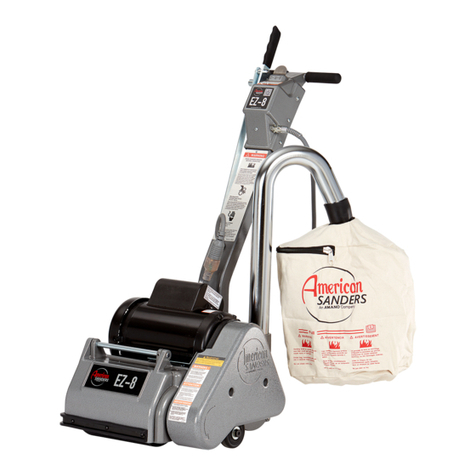
Clarke American Sanders
Clarke American Sanders EZ-8 User manual

Clarke American Sanders
Clarke American Sanders FloorCrafter 07104A User manual

Clarke American Sanders
Clarke American Sanders RS-16 User manual



